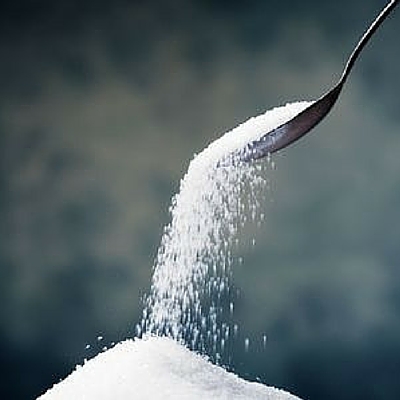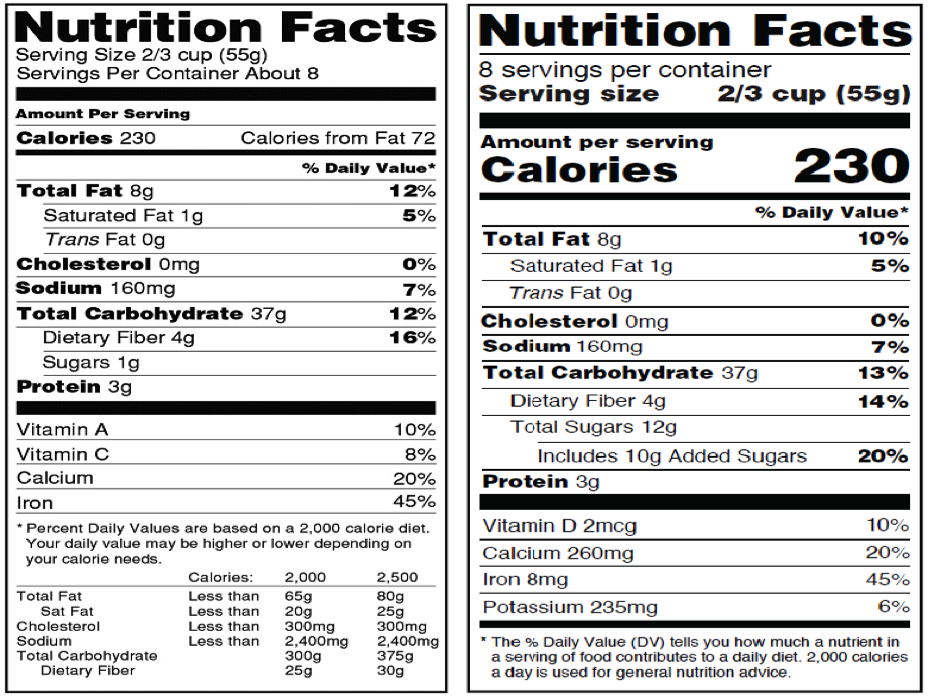
Added sugars in bakingSince its implementation in the 1990’s the FDA has been playing catch up with nutrition labeling in consumer packaged foods. The latest revisions to the nutritional labeling changes could cause confusion for the baking industry. The newest category to be added to the % Daily Value is added sugars. The current labeling system lumps all sugar under the Carbohydrate category listing Sugars. The new nutritional label will require a subcategory of added sugars to be listed under Carbohydrate just below Sugars. The examples below are from the FDA’s Food Guidance and Regulation site
Label Format: Original vs. New

Note: The images above are meant for illustrative purposes to show how the new Nutrition Facts label might look compared to the old label. Both labels represent fictional products. When the original hypothetical label was developed in 2014 (the image on the left-hand side), added sugars was not yet proposed so the “original” label shows 1g of sugar as an example. The image created for the “new” label (shown on the right-hand side) lists 12g total sugar and 10g added sugar to give an example of how added sugars would be broken out with a % Daily Value.
The FDA is defining added sugars as sugar that has been added to products during the manufacturing process. This is to differentiate naturally occurring sugar found in milk or fruit for example from sucrose added for flavor enhancement. Added sugars commonly used are honey, high fructose corn syrup, nectar, sucrose, and many more. For a complete list of FDA recognized added sugars.
While added sugars are consistent from formula to finished product in ice cream or soda, the changes that occur in a fermented product such as bread could cause a higher value than the finished product contains. Fermentation creates a unique problem for bakers trying to adhere to the FDA’s new nutritional label category. The America Bakers Association states “there was no AOAC approved method of measurement and that bakery products have the added complexity of fermentation that utilizes sugar as part of the baking process.” The American Bakers Association partnered with the Retail Bakers of America to submit opposition to the proposed label changes in October 2015 citing unconfirmed scientific process for determining added sugar from naturally occurring sugar.
For example, a baker used 5g sugar in a 100g dough. Does she claim 5g? Or how can she show that maybe 2g was fermented? At this time, the FDA is only considering the added sugars % based on formula/recipe so she would have to add the whole 5g. It is possible for outside analytical testing of mix vs finished good to be used to give a more accurate % added sugar. Unfortunately, I could not find any information confirming that this sort of analysis is approved by the FDA. The expense of outside testing for all finished goods produced by a bakery would be very expensive.
How will this affect your bakery business?
Your business may fall under one of the exemptions for small businesses. The exemptions for FDA Food Labeling are based on business size, number of employees, number of units produced, or sales revenue. You must qualify for one of the following criteria.
-
Production: Low-volume products
- Fewer than an average of 100 full-time equivalent employees OR
- Fewer than 100,000 units of that product are sold in the United States in a 12-month period.
- Exemption must be filed annually with Food and Drug Administration (FDA).
- Products that bear nutrition claims do not qualify for an exemption.
-
Retail: Another type of exemption applies to retailers
- Annual gross sales of not more than $500,000 OR
- Annual gross sales of foods or dietary supplements to consumers of not more than $50,000.
- Notices do not need to be filed with the Food and Drug Administration (FDA).
If your business does not qualify for the small business exemption, you will have two years to implement the nutritional label changes from the approval date expected sometime in 2016. To comply, each product you produce will need to have new packaging and new nutritional analysis and labeling. Software specific to food labeling offer customers support when navigating the new federal requirements. The software is easy to use and allows staff to create package-ready labels. For companies with dozens of products, in-house software is very cost effective. Companies with fewer products might opt to outsource lab analysis to a testing agency. Outside testing can provide both formula and finished good analysis. Fermented foods could benefit from finished good testing in order to get a more accurate percent of added sugars.
Cited articles:
- Proposed Changes to the Nutrition Facts Label. (Oct 23, 2015).
- Kotche, K. FDA Proposes New Sugar Labeling Requirements. (July 28, 2015).
- Natural Sugars vs. Added Sugars (Feb 9, 2016).

